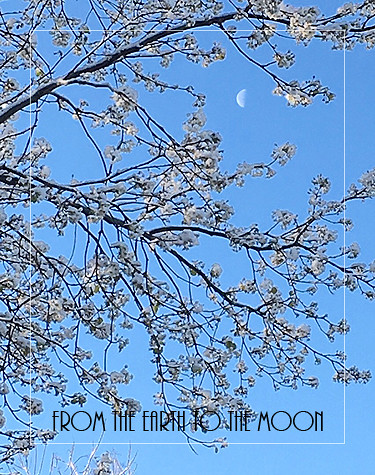
Volume XIV, Issue XVI
From the Earth to the Moon
By Jules Verne
CHAPTER III, EFFECT OF THE PRESIDENT'S
COMMUNICATION
It is impossible to describe the effect produced by the last words of the honorable president-- the cries, the shouts, the succession of roars, hurrahs, and all the varied vociferations which the American language is capable of supplying. It was a scene of indescribable confusion and uproar. They shouted, they clapped, they stamped on the floor of the hall. All the weapons in the museum discharged at once could not have more violently set in motion the waves of sound. One need not be surprised at this. There are some cannoneers nearly as noisy as their own guns.
Barbicane remained calm in the midst of this enthusiastic clamor; perhaps he was desirous of addressing a few more words to his colleagues, for by his gestures he demanded silence, and his powerful alarum was worn out by its violent reports. No attention, however, was paid to his request. He was presently torn from his seat and passed from the hands of his faithful colleagues into the arms of a no less excited crowd.
Nothing can astound an American. It has often been asserted that the word "impossible" is not a French one. People have evidently been deceived by the dictionary. In America, all is easy, all is simple; and as for mechanical difficulties, they are overcome before they arise. Between Barbicane's proposition and its realization no true Yankee would have allowed even the semblance of a difficulty to be possible. A thing with them is no sooner said than done.
The triumphal progress of the president continued throughout the evening. It was a regular torchlight procession. Irish, Germans, French, Scotch, all the heterogeneous units which make up the population of Maryland shouted in their respective vernaculars; and the "vivas," "hurrahs," and "bravos" were intermingled in inexpressible enthusiasm.
Just at this crisis, as though she comprehended all this agitation regarding herself, the moon shone forth with serene splendor, eclipsing by her intense illumination all the surrounding lights. The Yankees all turned their gaze toward her resplendent orb, kissed their hands, called her by all kinds of endearing names.
Between eight o'clock and midnight one optician in Jones'-Fall Street made his fortune by the sale of opera-glasses.
Midnight arrived, and the enthusiasm showed no signs of diminution. It spread equally among all classes of citizens-- men of science, shopkeepers, merchants, porters, chair-men, as well as "greenhorns," were stirred in their innermost fibres. A national enterprise was at stake. The whole city, high and low, the quays bordering the Patapsco, the ships lying in the basins, disgorged a crowd drunk with joy, gin, and whisky. Every one chattered, argued, discussed, disputed, applauded, from the gentleman lounging upon the barroom settee with his tumbler of sherry-cobbler before him down to the waterman who got drunk upon his "knock-me-down" in the dingy taverns of Fell Point.
About two A.M., however, the excitement began to subside. President Barbicane reached his house, bruised, crushed, and squeezed almost to a mummy. Hercules could not have resisted a similar outbreak of enthusiasm. The crowd gradually deserted the squares and streets. The four railways from Philadelphia and Washington, Harrisburg and Wheeling, which converge at Baltimore, whirled away the heterogeneous population to the four corners of the United States, and the city subsided into comparative tranquility.
On the following day, thanks to the telegraphic wires, five hundred newspapers and journals, daily, weekly, monthly, or bi-monthly, all took up the question. They examined it under all its different aspects, physical, meteorological, economical, or moral, up to its bearings on politics or civilization. They debated whether the moon was a finished world, or whether it was destined to undergo any further transformation. Did it resemble the earth at the period when the latter was destitute as yet of an atmosphere? What kind of spectacle would its hidden hemisphere present to our terrestrial spheroid? Granting that the question at present was simply that of sending a projectile up to the moon, every one must see that that involved the commencement of a series of experiments. All must hope that some day America would penetrate the deepest secrets of that mysterious orb; and some even seemed to fear lest its conquest should not sensibly derange the equilibrium of Europe.
The project once under discussion, not a single paragraph suggested a doubt of its realization. All the papers, pamphlets, reports-- all the journals published by the scientific, literary, and religious societies enlarged upon its advantages; and the Society of Natural History of Boston, the Society of Science and Art of Albany, the Geographical and Statistical Society of New York, the Philosophical Society of Philadelphia, and the Smithsonian of Washington sent innumerable letters of congratulation to the Gun Club, together with offers of immediate assistance and money.
From that day forward Impey Barbicane became one of the greatest citizens of the United States, a kind of Washington of science. A single trait of feeling, taken from many others, will serve to show the point which this homage of a whole people to a single individual attained.
Some few days after this memorable meeting of the Gun Club, the manager of an English company announced, at the Baltimore theatre, the production of "Much ado about Nothing." But the populace, seeing in that title an allusion damaging to Barbicane's project, broke into the auditorium, smashed the benches, and compelled the unlucky director to alter his playbill. Being a sensible man, he bowed to the public will and replaced the offending comedy by "As you like it"; and for many weeks he realized fabulous profits.
(to be continued)
Faith and Beauty
Images that Lead to Worship and Relationship with God
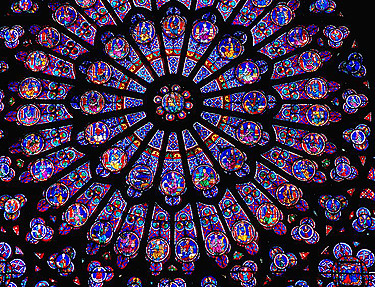
North Rose Window, Notre Dame de Paris.
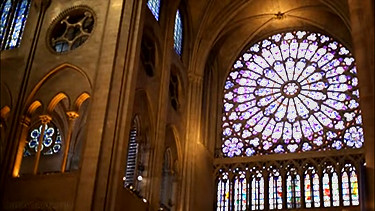
North Rose Window, Notre Dame de Paris.
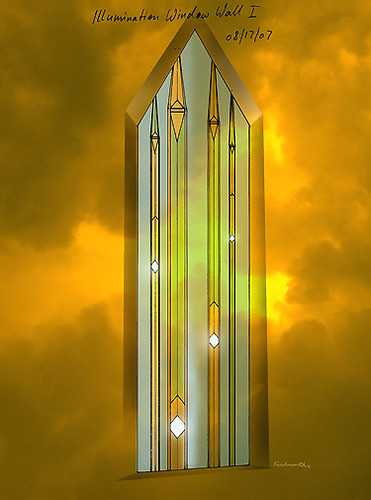
Sound Sculpture, Xaver Wilhelmy's design for functional glass organ pipes in a window combines beautiful visual imagery with beautiful music. Rendering by Bob Kirchman.
Catholicism and Beauty
By Bishop Robert Barron
A refreshing perspective on the place of the beautiful in leading to Faith.
Plato's Symposium
[click to read]
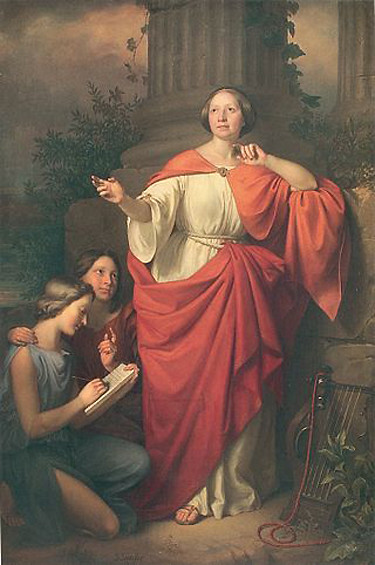
Diotima, painting by Józef Simmler, 1855. In Plato's Symposium the members of a party discuss the meaning of love. Socrates says that in his youth he was taught "the philosophy of love" by Diotima, who was a seer or priestess. Socrates also claims that Diotima successfully postponed the Plague of Athens. In a dialogue that Socrates recounts at the symposium, Diotima gives Socrates a genealogy of Love (Eros), stating that he is the son of "resource and poverty". In her view, love is a means of ascent to contemplation of the Divine. For Diotima, the most correct use of love of other human beings is to direct one's mind to love of Divinity. The beautiful beloved inspires the mind and the soul and directs one's attention to spiritual things. One proceeds from recognition of another's beauty, to appreciation of Beauty as it exists apart from any individual, to consideration of Divinity, the source of Beauty, to love of Divinity.
Concerning the things about which you ask to be informed I believe that I am not ill-prepared with an answer. For the day before yesterday I was coming from my own home at Phalerum to the city, and one of my acquaintance, who had caught a sight of me from behind, hind, out playfully in the distance, said: Apollodorus, O thou Phalerian man, halt! So I did as I was bid; and then he said, I was looking for you, Apollodorus, only just now, that I might ask you about the speeches in praise of love, which were delivered by Socrates, Alcibiades, and others, at Agathon's supper. Phoenix, the son of Philip, told another person who told me of them; his narrative was very indistinct, but he said that you knew, and I wish that you would give me an account of them. Who, if not you, should be the reporter of the words of your friend? And first tell me, he said, were you present at this meeting? (read more)
Love is...
The Ultimate Definition
Love never gives up.
Love cares more for others than for self.
Love doesn’t want what it doesn’t have.
Love doesn’t strut,
Doesn’t have a swelled head,
Doesn’t force itself on others,
Isn’t always “me first,”
Doesn’t fly off the handle,
Doesn’t keep score of the sins of others,
Doesn’t revel when others grovel,
Takes pleasure in the flowering of truth,
Puts up with anything,
Trusts God always,
Always looks for the best, Never looks back,
But keeps going to the end.
— 1 Corinthians 13:4-7 (MSG)
The Answer is IMAGO DEI
Start by Acknowledging the Image of God
By David M. Bailey
[click to read]
If you were to ask a random sample of people whether race matters in American society anymore, you would get a variety of answers. Many would say that great strides have been made since the civil rights movement. Looking back at Martin Luther King’s “I Have a Dream Speech,” they would offer that people are now judged by the content of their character rather than the color of their skin. Others would contest that racial identity still strongly influences many aspects of their lives in American society. How do we reconcile such opposing opinions? (read more)
Inventions Ahead of their Time
Innovation is Not Always Immediately Rewarding
It is fair to say that in many cases the principle preceded practicality.
From the Earth to the Moon
By Jules Verne
CHAPTER IV, REPLY FROM THE OBSERVATORY OF CAMBRIDGE
Barbicane, however, lost not one moment amid all the enthusiasm of which he had become the object. His first care was to reassemble his colleagues in the board-room of the Gun Club. There, after some discussion, it was agreed to consult the astronomers regarding the astronomical part of the enterprise. Their reply once ascertained, they could then discuss the mechanical means, and nothing should be wanting to ensure the success of this great experiment.
A note couched in precise terms, containing special interrogatories, was then drawn up and addressed to the Observatory of Cambridge in Massachusetts. This city, where the first university of the United States was founded, is justly celebrated for its astronomical staff. There are to be found assembled all the most eminent men of science. Here is to be seen at work that powerful telescope which enabled Bond to resolve the nebula of Andromeda, and Clarke to discover the satellite of Sirius. This celebrated institution fully justified on all points the confidence reposed in it by the Gun Club. So, after two days, the reply so impatiently awaited was placed in the hands of President Barbicane.
It was couched in the following terms:
The Director of the Cambridge Observatory to the President of the Gun Club at Baltimore.
CAMBRIDGE, October 7. On the receipt of your favor of the 6th instant, addressed to the Observatory of Cambridge in the name of the members of the Baltimore Gun Club, our staff was immediately called together, and it was judged expedient to reply as follows:
The questions which have been proposed to it are these--
1. Is it possible to transmit a projectile up to the moon?
2. What is the exact distance which separates the earth from its satellite?
3. What will be the period of transit of the projectile when endowed with sufficient initial velocity? and, consequently, at what moment ought it to be discharged in order that it may touch the moon at a particular point?
4. At what precise moment will the moon present herself in the most favorable position to be reached by the projectile?
5. What point in the heavens ought the cannon to be aimed at which is intended to discharge the projectile?
6. What place will the moon occupy in the heavens at the moment of the projectile's departure?"
Regarding the first question, "Is it possible to transmit a projectile up to the moon?"
Answer.-- Yes; provided it possess an initial velocity of 1,200 yards per second; calculations prove that to be sufficient. In proportion as we recede from the earth the action of gravitation diminishes in the inverse ratio of the square of the distance; that is to say, at three times a given distance the action is nine times less. Consequently, the weight of a shot will decrease, and will become reduced to zero at the instant that the attraction of the moon exactly counterpoises that of the earth; that is to say at 47/52 of its passage. At that instant the projectile will have no weight whatever; and, if it passes that point, it will fall into the moon by the sole effect of the lunar attraction. The theoretical possibility of the experiment is therefore absolutely demonstrated; its success must depend upon the power of the engine employed.
As to the second question, "What is the exact distance which separates the earth from its satellite?"
Answer.-- The moon does not describe a circle round the earth, but rather an ellipse, of which our earth occupies one of the foci; the consequence, therefore, is, that at certain times it approaches nearer to, and at others it recedes farther from, the earth; in astronomical language, it is at one time in apogee, at another in perigee. Now the difference between its greatest and its least distance is too considerable to be left out of consideration. In point of fact, in its apogee the moon is 247,552 miles, and in its perigee, 218,657 miles only distant; a fact which makes a difference of 28,895 miles, or more than one-ninth of the entire distance. The perigee distance, therefore, is that which ought to serve as the basis of all calculations.
To the third question. Answer.-- If the shot should preserve continuously its initial velocity of 12,000 yards per second, it would require little more than nine hours to reach its destination; but, inasmuch as that initial velocity will be continually decreasing, it will occupy 300,000 seconds, that is 83hrs.
20m. in reaching the point where the attraction of the earth and moon will be in equilibrio. From this point it will fall into the moon in 50,000 seconds, or 13hrs. 53m. 20sec. It will be desirable, therefore, to discharge it 97hrs. 13m. 20sec. before the arrival of the moon at the point aimed at. Regarding question four, "At what precise moment will the moon present herself in the most favorable position, etc.?" Answer.-- After what has been said above, it will be necessary, first of all, to choose the period when the moon will be in perigee, and also the moment when she will be crossing the zenith, which latter event will further diminish the entire distance by a length equal to the radius of the earth, i. e. 3,919 miles; the result of which will be that the final passage remaining to be accomplished will be 214,976 miles. But although the moon passes her perigee every month, she does not reach the zenith always at exactly the same moment. She does not appear under these two conditions simultaneously, except at long intervals of time. It will be necessary, therefore, to wait for the moment when her passage in perigee shall coincide with that in the zenith. Now, by a fortunate circumstance, on the 4th of December in the ensuing year the moon will present these two conditions. At midnight she will be in perigee, that is, at her shortest distance from the earth, and at the same moment she will be crossing the zenith.
On the fifth question, "At what point in the heavens ought the cannon to be aimed?"
Answer.-- The preceding remarks being admitted, the cannon ought to be pointed to the zenith of the place. Its fire, therefore, will be perpendicular to the plane of the horizon; and the projectile will soonest pass beyond the range of the terrestrial attraction. But, in order that the moon should reach the zenith of a given place, it is necessary that the place should not exceed in latitude the declination of the luminary; in other words, it must be comprised within the degrees 0@ and 28@ of lat. N. or S. In every other spot the fire must necessarily be oblique, which would seriously militate against the success of the experiment.
As to the sixth question, "What place will the moon occupy in the heavens at the moment of the projectile's departure?"
Answer.-- At the moment when the projectile shall be discharged into space, the moon, which travels daily forward 13@ 10' 35'', will be distant from the zenith point by four times that quantity, i. e. by 52@ 41' 20'', a space which corresponds to the path which she will describe during the entire journey of the projectile. But, inasmuch as it is equally necessary to take into account the deviation which the rotary motion of the earth will impart to the shot, and as the shot cannot reach the moon until after a deviation equal to 16 radii of the earth, which, calculated upon the moon's orbit, are equal to about eleven degrees, it becomes necessary to add these eleven degrees to those which express the retardation of the moon just mentioned: that is to say, in round numbers, about sixty-four degrees. Consequently, at the moment of firing the visual radius applied to the moon will describe, with the vertical line of the place, an angle of sixty-four degrees.
These are our answers to the questions proposed to the Observatory of Cambridge by the members of the Gun Club:
To sum up--
1st. The cannon ought to be planted in a country situated between 0@ and 28@ of N. or S. lat.
2nd. It ought to be pointed directly toward the zenith of the place.
3rd. The projectile ought to be propelled with an initial velocity of 12,000 yards per second.
4th. It ought to be discharged at 10hrs. 46m. 40sec. of the 1st of December of the ensuing year.
5th. It will meet the moon four days after its discharge, precisely at midnight on the 4th of December, at the moment of its transit across the zenith.
The members of the Gun Club ought, therefore, without delay, to commence the works necessary for such an experiment, and to be prepared to set to work at the moment determined upon; for, if they should suffer this 4th of December to go by, they will not find the moon again under the same conditions of perigee and of zenith until eighteen years and eleven days afterward.
The staff of the Cambridge Observatory place themselves entirely at their disposal in respect of all questions of theoretical astronomy; and herewith add their congratulations to those of all the rest of America. For the Astronomical Staff, J. M. BELFAST, Director of the Observatory of Cambridge.
(to be continued)
Daffodils in Snow
Photos by Bob Kirchman



